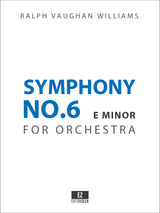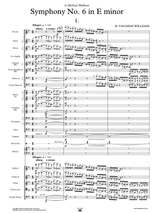
Ralph Vaughan Williams composed his Symphony in E minor, published as Symphony No. 6, in 1944–47, during and immediately after World War II and revised in 1950. Dedicated to Michael Mullinar, it was first performed, in its original version, by Sir Adrian Boult and the BBC Symphony Orchestra on 21 April 1948. Within a year it had received some 100 performances, including the U.S. premiere by the Boston Symphony Orchestra under Serge Koussevitzky on 7 August 1948. Leopold Stokowski gave the first New York performances the following January with the New York Philharmonic and immediately recorded it, declaring that "this is music that will take its place with the greatest creations of the masters."
Perhaps the composer never intended the symphony to be programmatic, but it was inevitable that his post-war audience should associate its disturbing and often violent character with the detonation of the atomic bombs over Hiroshima and Nagasaki. In response to these questions, he is widely quoted as having said, "It never seems to occur to people that a man might just want to write a piece of music". In connection with the last movement, the composer did eventually suggest that a quotation from Act IV of Shakespeare's The Tempest comes close to the music's meaning: "We are such stuff / As dreams are made on; and our little life / Is rounded with a sleep."
The deaths of the band members in the Café de Paris bombing in 1941 moved him to incorporate elements of jazz, including a saxophone solo in the Scherzo movement. This influence was noted by the conductor Malcolm Sargent who took the symphony on its initial tour around the world.
The Symphony is noteworthy for its unusually discordant harmonic language, reminiscent in approach if not in technique of his Symphony No. 4 from over a decade earlier, and for its inclusion of a tenor saxophone among the woodwinds. In several respects this symphony marks the beginning of Vaughan Williams's experiments with orchestration that so characterize his late music.
The symphony is in four linked movements (i.e. one movement leads straight into the next, with no pause between them), and includes a number of ideas that return in various guises throughout the symphony, for example the use of simultaneous chords a half-step apart, or the short-short-long rhythmic figure.
- Difficulty:
- Advanced
- Instrumentation:
- Picc d. Fl3, 2Fl, 2Ob, CA, 2Cl, BCl, TenSax, 2Bsn, Cbsn, 4Hn, 3Tpt(4th ad lib), 3Tbn, Tba, Timp, Perc(3),Hp(s), Strings
- Duration:
- ca. 32 minutes
- Set of Parts:
- Includes Strings count 4.4.3.3.2
- Extra Strings:
- Only available with the purchase of the Set of Parts






